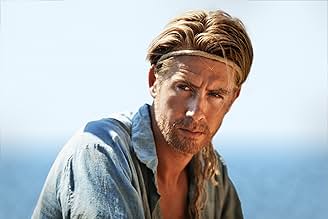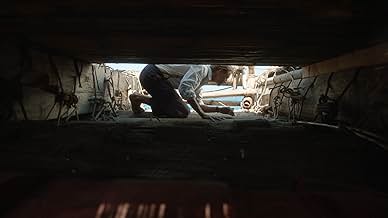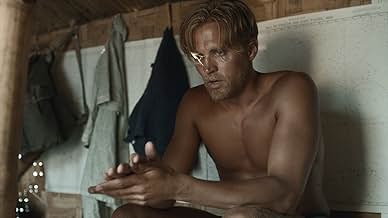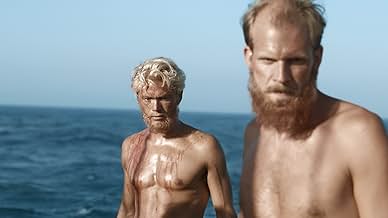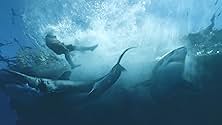Em 1947, o norueguês Thor Heyerdahl e mais cinco amigos navegam em uma balsa frágil para cruzar quase 7.000 km da América do Sul à Polinésia.Em 1947, o norueguês Thor Heyerdahl e mais cinco amigos navegam em uma balsa frágil para cruzar quase 7.000 km da América do Sul à Polinésia.Em 1947, o norueguês Thor Heyerdahl e mais cinco amigos navegam em uma balsa frágil para cruzar quase 7.000 km da América do Sul à Polinésia.
- Direção
- Roteirista
- Artistas
- Indicado a 1 Oscar
- 12 vitórias e 14 indicações no total
- Thor Heyerdahl
- (as Pål Hagen)
- Herman Watzinger
- (as Anders Baasmo Christiansen)
- Thor 6 yrs.
- (as Kasper Ameberg Johnsen)
Avaliações em destaque
During the 20th century some individual achievements so captured the popular attention as to become iconic: Lindberg's flight across the Atlantic, Hillary and Norgay's conquest of Everest, Roger Bannister's four minute mile. Thor Heyerdahl's 1947 voyage across the Pacific was one of these events. His book, Kon-Tiki, sold tens of millions of copies, and his 1950 documentary won an Academy Award, as much a recognition of the feat as the film.
Norwegian directors Joachim Rønning and Espen Sandberg have now decided to put on the screen a dramatized account of Heyerdahl's expedition. But the obvious question is how can you make interesting the story of six men confined to a small wooden raft for 101 days? In fact by comparison to the exploit it recorded, the original documentary came across as rather bland, precisely because of such limitations. But this new film is anything but tame, and succeeds in combining striking photography of the adventure itself with a compelling look at one man's quest to show that "it can be done."
The strength of the picture is that it situates the voyage within the context of Heyerdahl's struggle to get the scientific and financial support to try out his theories. He had speculated that Polynesia was settled by Inca voyagers who had used the prevailing currents to drift across the Pacific on rafts similar to the one he would build. (He proved this possible, although DNA testing suggests that Polynesians share a predominantly Asian heritage.)
Heyerdahl had developed this premise much earlier, but after World War II, he made serious attempts to secure the backing for a voyage that would test his theories. Not only did he encounter opposition from those who felt that he was wrong, but even more often he was dismissed as a fanatic with a suicidal plan.
Eventually he did manage to scrounge some backing, including private loans, help from the Peruvian authorities and supplies from the U.S. Navy. Perhaps more importantly, he found five companions who had confidence enough to put their lives in his hands. All were Norwegian except Bengt Danielsson, a Swede with an interest in migration. Erik Hesselberg was the navigator. Knut Haugland and Torstein Raaby, both heroes of the Norwegian resistance, were the radio experts. Herman Watzinger was an engineer who helped design the raft, and who recorded much of the voyage's scientific data.
Although he took along modern equipment, Heyerdahl was concerned that the raft itself should be constructed only from materials that were available in ancient times. Accordingly the raft was constructed from logs tied together with rope, surmounted by a thatched cabin and a large cloth sail. The raft itself was about 45 by 18 feet (13.7 by 5.5 m), and the cabin about 14 by 8 (4.2 by 2.4 m). The crew sailed from Callao, Peru, on April 28, 1947 and arrived in Raroia in the Tuamotu Islands on August 7.
The film succeeds by contextualizing these 101 days at sea against Heyerdahl's struggles to get the expedition underway. Although the inevitable storm and the equally foreseeable shark attack have their moments, the movie similarly attends to the relationships among the expedition's six members, their level of bonding to Heyerdahl as leader, and his own relationship with a wife who wanted to be supportive, but who found the risks unacceptable. It establishes the overall context by its early sequence dealing with Thor's honeymoon stay in the Marquesas, where he began to discover the apparent Inca connections that led to his theories.
In the central role of Thor Heyerdahl, Pål Sverre Valheim Hagen must carry the story, and he does. His re-creation of the historical character is convincing as the embodiment of determination, not quite obsessive but coming close, as he plans, argues and cajoles to try to turn his project into a reality. As his fellow Norwegian crew members Odd Magnus Williamson as Hesselberg, Tobias Santlemann as Haugland, and Jacob Oftebro as Raaby are equally credible figures: young, heroic, and willing to give Heyerdahl their trust. Playing the only non-Norwegian in the group, Gustaf Skarsgård as Bengt Danielsson is a little detached, but perhaps even more intellectually committed than the others to what they are about. For contrast and drama, the filmmakers apparently took liberties with the character of Herman Watzinger, played by Anders Baasmo Christensen. Christensen does well with the part given him, although the real-life Watzinger was almost certainly stronger and more competent than the movie shows him. Given that she must play an ambivalent role, Agnes Kittelsen as Liv gives a very effective performance as Thor's wife and the film's only prominent female character.
Gorgeous photography and great production values set Kon-Tiki off. The Pacific Ocean scenes were actually shot in the waters off Malta, the tropical ones in the Maldives and Thailand, with other locations in Norway and the U.S. used as appropriate. It is a real accomplishment that even with the limited space of the raft cinematographer Geir Hartly Andreassen never lets it become visually boring. Going from the micro to the macro, he manages to keep interesting also the vast empty spaces of the ocean, which emerges as a living character in its own right, often peaceful, sometimes petrifying, always powerful.
It must have been a temptation for the directors and principal screenwriter Petter Skavlan to fictionalize Heyerdahl's exploits and to create a stunning action/adventure tale on the lines of A Perfect Storm or White Squall. Thankfully they recognized that Heyerdahl himself was a character larger than life whose daring voyage became an extension of himself and his ambitions. In doing that they keep alive the iconic figure that he was, and give audiences some appreciation of how the sheer willpower of one individual can produce deeds that capture the imagination of the world.
Awesome retelling about the dangerous adventure starred by Thor and a valiant group of heroes . Big budget production with gorgeous scenarios , colorful images , thrills , emotion and sense of style . Large parts of the film were filmed in two versions at the same time, one in Norwegian, the other in English, in order to secure international funding. Including wide participation from several nations , as there take part Sweden, Bulgaria , Norway , Malta , Maldives crews . Glamorous and glimmer cinematography by Geir Hartly Andreassen . Special mention to sensitive as well as evocative original Music by Johan Söderqvist . Lavishly produced among several countries such as UK | Norway | Denmark | Germany | Sweden with important financing by great producer Jeremy Thomas . The film's producer, Jeremy Thomas, had wanted to make the film since 1996 and was granted the rights to the story by Thor Heyerdahl before the latter's death in 2002 . The motion picture was compellingly directed by Joachim Rønning (Bandidas , Max Manus) and Espen Sandberg and it was the official submission of Norway to the Best Foreign Language Film of the 85th Academy Awards 2013.
The film was well based on real events , these are the followings : Kon-Tiki was the raft used by Norwegian explorer and writer Thor Heyerdahl in his 1947 expedition across the Pacific Ocean from South America to the Polynesian islands. It was named after the Inca sun god, Viracocha, for whom "Kon-Tiki" was said to be an old name. Kon-Tiki is also the name of Heyerdahl's book; the Academy Award-winning documentary film chronicling his adventures; and the 2012 dramatised feature film nominated for the Academy Award for Best Foreign Language Film.Heyerdahl believed that people from South America could have settled Polynesia in pre-Columbian times. Although most anthropologists as of 2010 had come to the conclusion they did not, in 2011, new genetic evidence was uncovered by Erik Thorsby that Easter Island inhabitants do have some South American DNA, lending credence to at least some of Heyerdahl's theses. His aim in mounting the Kon-Tiki expedition was to show, by using only the materials and technologies available to those people at the time, that there were no technical reasons to prevent them from having done so. Although the expedition carried some modern equipment, such as a radio, watches, charts, sextant, and metal knives, Heyerdahl argued they were incidental to the purpose of proving that the raft itself could make the journey.The Kon-Tiki expedition was funded by private loans, along with donations of equipment from the United States Army. Heyerdahl and a small team went to Peru, where, with the help of dockyard facilities provided by the Peruvian authorities, they constructed the raft out of balsa logs and other native materials in an indigenous style as recorded in illustrations by Spanish conquerers. The trip began on April 28, 1947. Heyerdahl and five companions sailed the raft for 101 days over 6900 km (4,300 miles) across the Pacific Ocean before smashing into a reef at Raroia in the Tuamotu Islands on August 7, 1947. The crew made successful landfall and all returned safely.Thor Heyerdahl's book about his experience became a bestseller. It was published in Norwegian in 1948 as The Kon-Tiki Expedition: By Raft Across the South Seas, later reprinted as Kon-Tiki: Across the Pacific in a Raft. It appeared with great success in English in 1950, also in many other languages. A documentary motion picture about the expedition, also called Kon-Tiki was produced from a write-up and expansion of the crew's filmstrip notes and won an Academy Award in 1951. It was directed by Thor Heyerdahl and edited by Olle Nordemar. The voyage was also chronicled in the documentary TV-series The Kon-Tiki Man: The Life and Adventures of Thor Heyerdahl, directed by Bengt Jonson.The original Kon-Tiki raft is now on display in the Kon-Tiki Museum in Oslo.
NB: now willing to watch the original Kon-Tiki documentary film, that won Oscar in 1950, directed by Thor Heyerdahl himself during their expedition___:))))
*** (out of 4)
Visually stunning telling of explorer Thor Heyerdahl's (Pal Sverre Hagen) epic and now legendary journey traveling nearly 5,000 miles from Peru to Polynesia in a wooden raft. Directors Joachim Ronning and Espen Sandberg certainly do a marvelous job in bringing this story to the screen, although I think the screenplay at times could have given more information than what we're just seeing. I think a little more character development might have helped the film somewhat but there's still no question that this here is mighty impressive and especially considering the budget. I think the best thing in the film is the wonderful visuals and right from the start they just leap right off the screen. Whether it's the snowy landscape of Norway or the beautiful blues of the sea, the look of this movie is something that makes you just want to pause the film and admire its beauty. The cinematography is top-notch and I'd argue some of the best that I've seen in recent years. The cinematography certainly helps grab all of these beautiful images but I also think it's so good that it also takes the viewer and places them directly on the boat to experience everything that happens. As for the real story, seeing it unfold here makes for a thrilling adventure that deals with some bickering between the men but also some breathtaking moments involving a whale and some highly intense scenes with sharks. The acting is another major plus as all the key people do a wonderful job in the film even while none of their characters really jump out at you except for the lead. The film is certainly very uplifting and inspirational and it really makes you respect these explorers for everything they did and of course their bravery. This film is certainly a fitting tribute to the men who went on this mission.
If nothing else, Kon-Tiki (the name of the aforementioned vessel) adds to the impressive list of superb films from Scandinavia this past year. From Headhunters (one of my favourites of 2012) to the overlooked Snabba cash (Easy Money), fare from this region has never been more accessible or memorable.
So now comes Kon-Tiki, the first Norwegian film to score both a nomination at the Golden Globe and Academy Award ceremonies, and it's rather easy to see why. This sweeping journey appeals squarely to Hollywood sensibilities, twisting up an epic, historical adventure about overcoming the odds, with human drama. Though this intentional slanting may take some of the complexity and grit out of the film in the end, praise is abundantly deserved for all those involved.
Chief on that list is filmmaking duo Joachim Rønning and Espen Sandberg, best known previously for the Luc Besson-produced Bandidas with Penelope Cruz and Selma Hayek, who craft something lavish and visually sumptuous out of this trek, despite the hurdle of being endowed with a budget of just $16 million.
By recreating Heyerdahl's raft, shooting out over the deep and using special effects only as infrequent enhancements rather than a crutch, these two lay the authenticity on thick and in doing so generate tension and wonder (sometimes simultaneously) like you wouldn't imagine. Kon- Tiki, though never overtly stealing, mirrors the most effective aspects of films like Cast Away, Jaws and Mutiny on the Bounty.
When Rønning and Sandberg aren't capturing sweeping, stunning shots of the Pacific (and the tiny boat at its mercy) they are letting the camera rest on the diminutive aspects of the voyage, at least so when compared to the grandness of what's around them. The ropes lashing together the massive balsa wood beams strain and groan in the water, summoning us back to an earlier scene where two sailors warn Heyerdahl that a raft of that nature will inevitably break apart with the movement of the logs. Sharks silently circle and the boat slowly crumbles as the wood absorbs seawater. These quiet moments are as unnerving as anything you'll see on the big screen.
Likewise, there are grander, more elaborate moments that drip with tension all the same, as when storms hit, men are cast overboard, and once again sharks, though proving to be one of the lesser threats in the scheme of things, use their mythos alone to chill to the bone. If not as complex as it could have been, Kon-Tiki is certainly never dull.
The cast of unknown actors are also strong, even if by the time the credits role their sporting of Grizzly Adams-like beards makes identifying between some of these brave men difficult. Leading the way as the driven Heyerdahl is – wait for this one – Pål Sverre Valheim Hagen, anchoring (no pun intended) the film as a man intent on proving his settlement theory to sceptical scholars. Joining him is engineer (and refrigerator salesman) Herman Watzinger (Anders Baasmo Christiansen) navigator Erik Hesselberg (Odd Magnus Williamson) ethnographer Bengt Danielsson (Gustaf Skarsgård) and two soldiers acting as radio men Knut Haugland and Torstein Raaby (Tobias Santelmann and Jakob Oftebro respectively).
Together, crammed together like sardines, they make the 101-day journey, each bringing not only their respective skill-sets but demons as well. Those versed in Heyerdahl's novel or the documentary of the voyage (the winner of the 1950 Oscar for Best Documentary Feature) may cry afoul at some of the changes that have been made in service to crafting a more dramatic effort, particularly tweaks to the Watzinger character, but they will in no way impact how most will respond to Kon-Tiki.
Though not as weighty or viscerally lasting as some fare that pops up in the Best Foreign Language Film category, it is, however, infinitely accessible to anyone who usually turns their nose up at that particular segment of the ceremony. Kon-Tiki is a strong import, fascinating and thrilling in equal measure and a film that is just as much about the perils of nature as it is about the gratification that comes with conquering it.
Você sabia?
- CuriosidadesLarge parts of the film were filmed in two versions at the same time, one in Norwegian, the other in English, in order to secure international funding. See ALTERNATE VERSIONS section for greater detail.
- Erros de gravaçãoThe crew were not worried about whether the ropes would hold the float together, as it is portrayed in the film. As we can see in the A Aventura de Kon-Tiki (1950) documentary, the balsa wood was much softer than the rope, and it was actually the rope that ate through the wood. The result was that the rope eventually was protected by the space that had been created around it.
- Citações
Epilogue: Bengt fell in love with Polynesia. He settled there and became a Consul General of Sweden. He died in 1997.
Epilogue: Erik built himself a sailboat, that became his home for 11 years. He worked as an artist until his death in 1972.
Epilogue: Torstein kept going on expeditions. He died in 1964 during an attempt to reach the North Pole on skis.
Epilogue: Knut resumed his career in military intelligence. He was also instrumental in the establishment of the Kon-Tiki museum. He died the Christmas of 2009.
Epilogue: Herman became the director of UN's Food and Agriculture organization. He died at Titica lake in 1986.
Epilogue: Thor wrote a book about Kon-Tiki. It was translated to over 70 languages, and sold over 50 million copies. The documentary about the expedition won an Oscar. Liv and Thor divorced after the Kon-Tiki expedition. Their boys lived with Liv, who later moved to the US where she died in 1969. Thor continued his work as an experimental archaeologist, author and explorer. He died in 2002.
- Cenas durante ou pós-créditosBefore the closing credits, short clips are shown in which original footage shot by Heyerdahl was reenacted by the "Kon-Tiki" actors: urinating overboard in the open sea, dancing with natives under palms, portraits, and the like. Along with this, brief notes concerning each crew member's path of life after the trip are given.
- Versões alternativasIn an unusual technique, the film was shot simultaneously in both Norwegian and English, with each scene being filmed twice, first in Norwegian and then in English, with the same actors. This resulted in two versions of the film to be released, one primarily for the Norwegian domestic market, the other for an international audience. In a few cases, such as action scenes and computer-generated sequences, they used the same shot, later adding English with dubbing.
- ConexõesFeatured in 70th Golden Globe Awards (2013)
- Trilhas sonorasFlickan i Havanna
("The girl in Havana")
Lyrics by Evert Taube (as Taube) and music by Horatio R. Palmer (as Palmer)
Principais escolhas
Detalhes
- Data de lançamento
- Países de origem
- Centrais de atendimento oficiais
- Idiomas
- Também conhecido como
- Un viaje fantástico
- Locações de filme
- Nu Boyana Film Studios, Sófia, Bulgária(New York exterior scenes)
- Empresas de produção
- Consulte mais créditos da empresa na IMDbPro
Bilheteria
- Orçamento
- US$ 16.600.000 (estimativa)
- Faturamento bruto nos EUA e Canadá
- US$ 1.517.410
- Fim de semana de estreia nos EUA e Canadá
- US$ 22.168
- 28 de abr. de 2013
- Faturamento bruto mundial
- US$ 22.842.887
- Tempo de duração1 hora 58 minutos
- Cor
- Mixagem de som
- Proporção
- 2.35 : 1
Contribua para esta página






